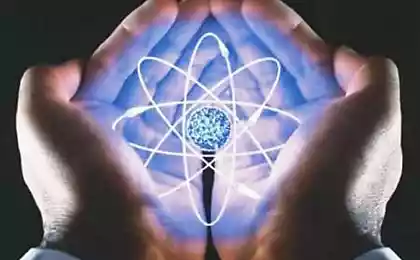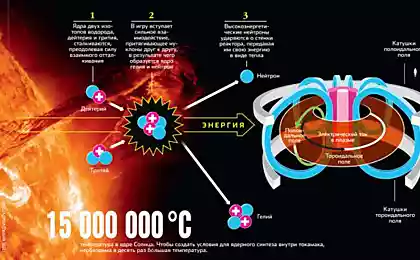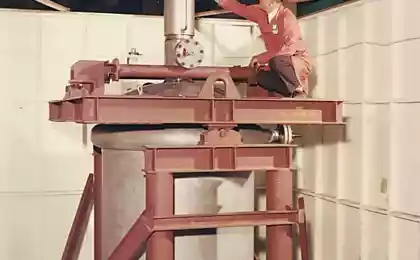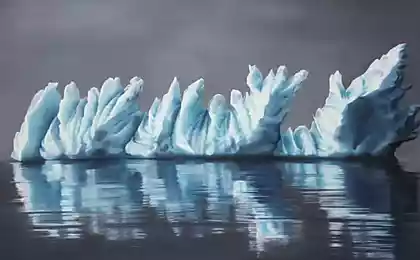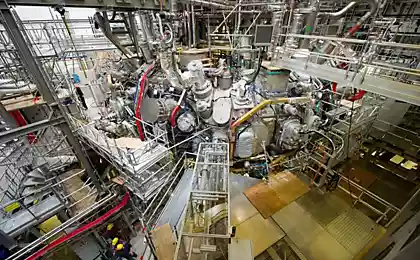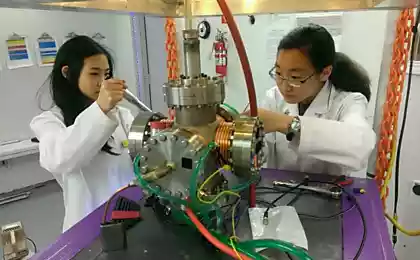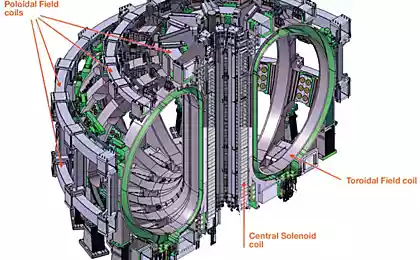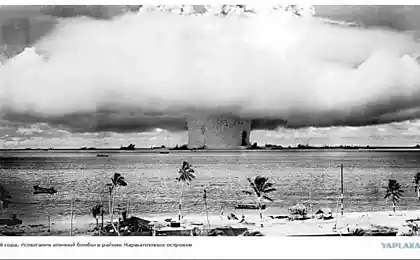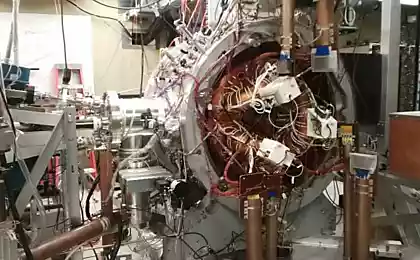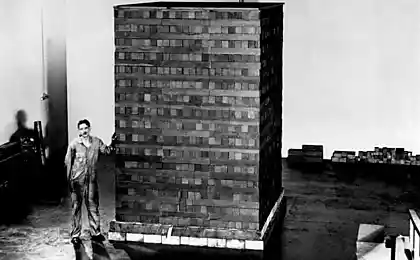469
What's wrong with nuclear fusion
A long-standing joke about fusion — what is our future source of energy and it always will be — perhaps is the biggest problem in this area. The desire to place the energy of the sun in a bottle has led to countless dreamy predictions about imminent revolution in the field of clean energy. But the expectation of the synthesis remained pending, the trust is long ago exhausted, and the public attitude to this issue has nothing to save.
Although our cynicism about the synthesis can be justified, it is also very sad. Because despite the cool support and ongoing funding problems, the researchers manage to achieve progress in the direction of this futuristic energy source. One day scientists will cope with all technical problems. Once.
Last week the editor of io9 visited the Princeton plasma physics laboratory to take a look at the updated experiment NSTX-U (National Spherical Torus Experiment), the most powerful "spherical tokamak" fusion reactor on Earth. 85-ton machine in the shape of a giant Apple uses high-energy particles to heat hydrogen atoms to temperatures of 100 million degrees Celsius, which is higher than in the core of the Sun. To keep this superhot plasma copper magnet coils generate a magnetic field 20,000 times stronger than Earth's. Everything to ensure that within a few magical seconds of the atomic nucleus encountered, was synthesized and released energy.
This experiment is a step on the way to create a set of synthesis, which will run constantly, capitiva entire cities with just one gram of sea water.
Sounds, of course, that's fine. But nuclear physics says the weighty no.
Nine million seven hundred seventeen thousand seven hundred forty nine
It is easy to understand why the field of fusion energy are prone to loud statements — the basis is just an incredible idea. But what is most striking during the tour of PPPL, this is not a magic science that's going on inside the giant reactor, the control center a La Houston, where dozens of scientists conduct simulations on supercomputers. Striking the balance of optimism about the future of fusion power and realism on the subject of complex physical and technical problems that need to be addressed on the way to this future.
"This is too good to be true: the idea that we will receive a source of infinite and carbon-free energy," says Clayton Myers, plasmaphysik of NSTX-U. — But nuclear physics says it is not. Proven only that a fusion reaction is real and that we can hold them".The first problem, as found by physicists in the 1950s and 1960s, is that the synthesized plasma — free current soup of protons and electrons, atomic nuclei which collide and emit energy, not like when it is held. She wants to splatter everywhere, and we need a high enough pressure and for a long time, so we can produce more energy than they spend on hold this plasma.
Our sun holds plasma by virtue of its gravity, but on Earth we have to rely on powerful magnets and lasers for this. And the cost of failure is very high. Even a tiny amount of runaway plasma can penetrate the wall of the reactor and stop the process.
The area of plasma physics has blossomed out of the desire to bottle a star in a bottle. Over the last few decades this area has grown in countless directions, from astrophysics to space weather and nanotechnology.
As soon as grow our overall understanding of plasma grew and our ability to maintain the synthesis conditions for more than seconds. Earlier this year, the new superconducting fusion reactor in China was able to keep the plasma temperature at 50 million degrees Celsius for a record 102 seconds. X Wendelstein-7 Stellarator, which is earned in Germany for the first time last fall, is expected to be able to beat the record and hold the plasma up to 30 minutes at a time.
A recent upgrade NSTX-U looks modest in comparison with these monsters: now the experiment can keep the plasma for five seconds instead of one. But it also is a milestone.
"The creation of a fusion plasma, which lives only five seconds may not seem like a very long process, but in plasma physics, five seconds can be compared with its physics in a stable condition," says Myers, referring to the conditions under which the plasma is stable. The ultimate goal is to achieve a steady-state "burning plasma" that can synthesis by itself due to the small energy input from the outside. No experiment yet this is not achieved.NSTX-U will allow Princeton researchers to fill some of the gaps between what is known from plasma physics now, and what will be necessary to create a pilot plant capable of reaching steady-state combustion and the generation of clean electricity.
On the one hand, to find the best materials to hold, we need to better understand what's going on between fusion plasma and reactor walls. At Princeton studying the possibility of replacing the walls of the reactor (carbon graphite) on the "wall" of liquid lithium with the aim of reducing long-term corrosion.
Everything else, scientists believe that if the synthesis will help in the fight against global warming, they need to hurry. NSTX-U will help physicists to decide whether or not to continue to develop the design of a spherical tokamak. Most reactors of the tokamak type to a lesser extent, similar to an Apple in shape and more on the doughnut, bagel, Thor. The unusual shape of the spherical torus allows more efficient use of the magnetic field of its coils.
"In the long term, we would like to find out how to optimize the configuration of one of these machines, says Martin Greenwald, Director of the Center for science plasma and fusion MIT. — For this you need to know how the performance of a car depends on what gives in your control, like the shape".
Myers hates to assess how far we are from the possible commercial fusion energy, and it can be understood. In the end, decades of endless optimism has caused serious harm to the reputation of this region and strengthened the idea that fusion is a pipe dream. With all the consequences for financing.
For program synthesis, MIT was a serious blow that the feds have given the support of the tokamak Alcator C-Mid, which produces one of the most powerful magnetic fields and demonstrates the synthesized plasma at higher pressure. Most of the expected research NSTX-U will depend on continued support at the Federal level, which, according to Myers, is "next year."
Everyone has to carefully spend the dollars allocated to research, and some program synthesis has sacrificed an incredible amount. Take, for example, ITER, a huge superconducting the synthesis reactor, which is currently being built in France. When 2005 began international cooperation, it was declared as a project of 5 billion dollars and 10 years. After several years of failure, the price tag rose to $ 40 billion. According to the most optimistic estimates, the project would be completed by 2030.
Where ITER is likely to swell like a tumor until they have exhausted the resources and not kill the host, stripped-down synthesis program at MIT shows how to do everything with a much smaller budget. Last summer, a team of graduate students from MIT presented plans for ARC fusion reactor with low-cost, which will use new high-temperature superconducting materials to generate the same amount of energy as ITER, only with a much smaller device.
Five million one hundred thirty eight thousand three hundred thirty four
"The problem of synthesis is to find the technical path that will make it economically attractive — that's what we plan to do in the near future, says Greenwald, noting that the concept of ARC is currently being carried out in the framework of the Energy Initiative at MIT. — We believe that if the synthesis will be important for global warming, we need to move faster.""Synthesis promises to be the main source of energy is, in fact, our ultimate goal," says Robert Rosner, plasmaphysik from the University of Chicago and co-founder of the Institute of energy policy. "At the same time have an important question: how much are we willing to spend right now. If we reduce funding to the point where the next generation of smart kids do not want to do it, we can all get out of this".P. S. And remember, only by changing their consumption — together we change the world! ©
Source: hi-news.ru/technology/chto-ne-tak-s-termoyadernym-sintezom.html
Although our cynicism about the synthesis can be justified, it is also very sad. Because despite the cool support and ongoing funding problems, the researchers manage to achieve progress in the direction of this futuristic energy source. One day scientists will cope with all technical problems. Once.
Last week the editor of io9 visited the Princeton plasma physics laboratory to take a look at the updated experiment NSTX-U (National Spherical Torus Experiment), the most powerful "spherical tokamak" fusion reactor on Earth. 85-ton machine in the shape of a giant Apple uses high-energy particles to heat hydrogen atoms to temperatures of 100 million degrees Celsius, which is higher than in the core of the Sun. To keep this superhot plasma copper magnet coils generate a magnetic field 20,000 times stronger than Earth's. Everything to ensure that within a few magical seconds of the atomic nucleus encountered, was synthesized and released energy.
This experiment is a step on the way to create a set of synthesis, which will run constantly, capitiva entire cities with just one gram of sea water.
Sounds, of course, that's fine. But nuclear physics says the weighty no.
Nine million seven hundred seventeen thousand seven hundred forty nine
It is easy to understand why the field of fusion energy are prone to loud statements — the basis is just an incredible idea. But what is most striking during the tour of PPPL, this is not a magic science that's going on inside the giant reactor, the control center a La Houston, where dozens of scientists conduct simulations on supercomputers. Striking the balance of optimism about the future of fusion power and realism on the subject of complex physical and technical problems that need to be addressed on the way to this future.
"This is too good to be true: the idea that we will receive a source of infinite and carbon-free energy," says Clayton Myers, plasmaphysik of NSTX-U. — But nuclear physics says it is not. Proven only that a fusion reaction is real and that we can hold them".The first problem, as found by physicists in the 1950s and 1960s, is that the synthesized plasma — free current soup of protons and electrons, atomic nuclei which collide and emit energy, not like when it is held. She wants to splatter everywhere, and we need a high enough pressure and for a long time, so we can produce more energy than they spend on hold this plasma.
Our sun holds plasma by virtue of its gravity, but on Earth we have to rely on powerful magnets and lasers for this. And the cost of failure is very high. Even a tiny amount of runaway plasma can penetrate the wall of the reactor and stop the process.
The area of plasma physics has blossomed out of the desire to bottle a star in a bottle. Over the last few decades this area has grown in countless directions, from astrophysics to space weather and nanotechnology.
As soon as grow our overall understanding of plasma grew and our ability to maintain the synthesis conditions for more than seconds. Earlier this year, the new superconducting fusion reactor in China was able to keep the plasma temperature at 50 million degrees Celsius for a record 102 seconds. X Wendelstein-7 Stellarator, which is earned in Germany for the first time last fall, is expected to be able to beat the record and hold the plasma up to 30 minutes at a time.
A recent upgrade NSTX-U looks modest in comparison with these monsters: now the experiment can keep the plasma for five seconds instead of one. But it also is a milestone.
"The creation of a fusion plasma, which lives only five seconds may not seem like a very long process, but in plasma physics, five seconds can be compared with its physics in a stable condition," says Myers, referring to the conditions under which the plasma is stable. The ultimate goal is to achieve a steady-state "burning plasma" that can synthesis by itself due to the small energy input from the outside. No experiment yet this is not achieved.NSTX-U will allow Princeton researchers to fill some of the gaps between what is known from plasma physics now, and what will be necessary to create a pilot plant capable of reaching steady-state combustion and the generation of clean electricity.
On the one hand, to find the best materials to hold, we need to better understand what's going on between fusion plasma and reactor walls. At Princeton studying the possibility of replacing the walls of the reactor (carbon graphite) on the "wall" of liquid lithium with the aim of reducing long-term corrosion.
Everything else, scientists believe that if the synthesis will help in the fight against global warming, they need to hurry. NSTX-U will help physicists to decide whether or not to continue to develop the design of a spherical tokamak. Most reactors of the tokamak type to a lesser extent, similar to an Apple in shape and more on the doughnut, bagel, Thor. The unusual shape of the spherical torus allows more efficient use of the magnetic field of its coils.
"In the long term, we would like to find out how to optimize the configuration of one of these machines, says Martin Greenwald, Director of the Center for science plasma and fusion MIT. — For this you need to know how the performance of a car depends on what gives in your control, like the shape".
Myers hates to assess how far we are from the possible commercial fusion energy, and it can be understood. In the end, decades of endless optimism has caused serious harm to the reputation of this region and strengthened the idea that fusion is a pipe dream. With all the consequences for financing.
For program synthesis, MIT was a serious blow that the feds have given the support of the tokamak Alcator C-Mid, which produces one of the most powerful magnetic fields and demonstrates the synthesized plasma at higher pressure. Most of the expected research NSTX-U will depend on continued support at the Federal level, which, according to Myers, is "next year."
Everyone has to carefully spend the dollars allocated to research, and some program synthesis has sacrificed an incredible amount. Take, for example, ITER, a huge superconducting the synthesis reactor, which is currently being built in France. When 2005 began international cooperation, it was declared as a project of 5 billion dollars and 10 years. After several years of failure, the price tag rose to $ 40 billion. According to the most optimistic estimates, the project would be completed by 2030.
Where ITER is likely to swell like a tumor until they have exhausted the resources and not kill the host, stripped-down synthesis program at MIT shows how to do everything with a much smaller budget. Last summer, a team of graduate students from MIT presented plans for ARC fusion reactor with low-cost, which will use new high-temperature superconducting materials to generate the same amount of energy as ITER, only with a much smaller device.
Five million one hundred thirty eight thousand three hundred thirty four
"The problem of synthesis is to find the technical path that will make it economically attractive — that's what we plan to do in the near future, says Greenwald, noting that the concept of ARC is currently being carried out in the framework of the Energy Initiative at MIT. — We believe that if the synthesis will be important for global warming, we need to move faster.""Synthesis promises to be the main source of energy is, in fact, our ultimate goal," says Robert Rosner, plasmaphysik from the University of Chicago and co-founder of the Institute of energy policy. "At the same time have an important question: how much are we willing to spend right now. If we reduce funding to the point where the next generation of smart kids do not want to do it, we can all get out of this".P. S. And remember, only by changing their consumption — together we change the world! ©
Source: hi-news.ru/technology/chto-ne-tak-s-termoyadernym-sintezom.html
Tatiana Krasnova: the exam — we learned to test, they have learned to pass
Fabulous green roofs of Northern Scandinavia


